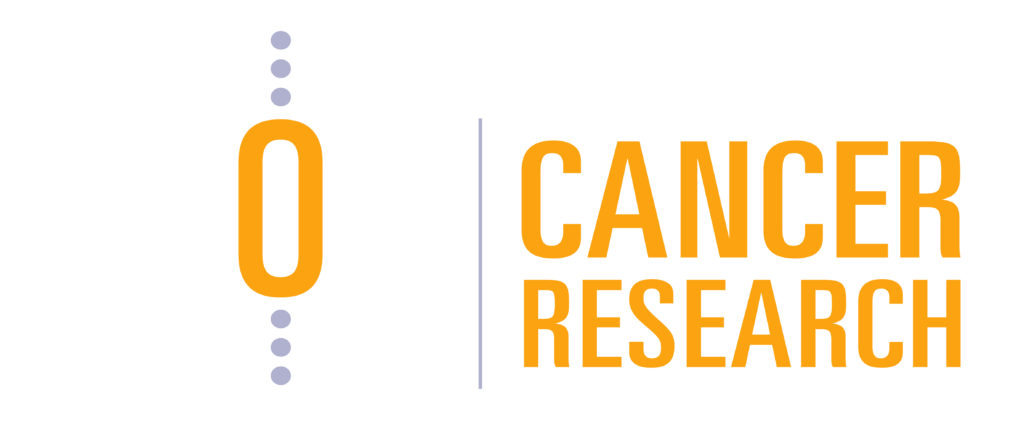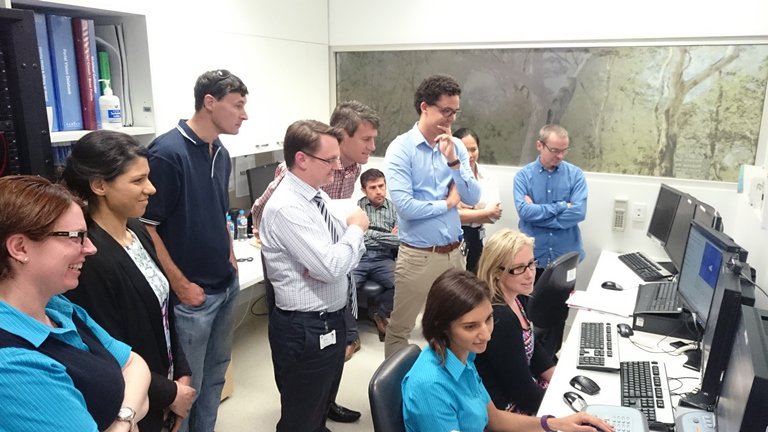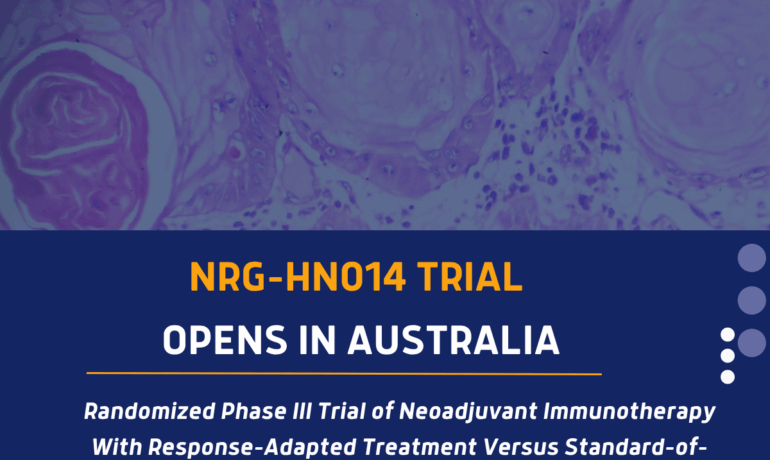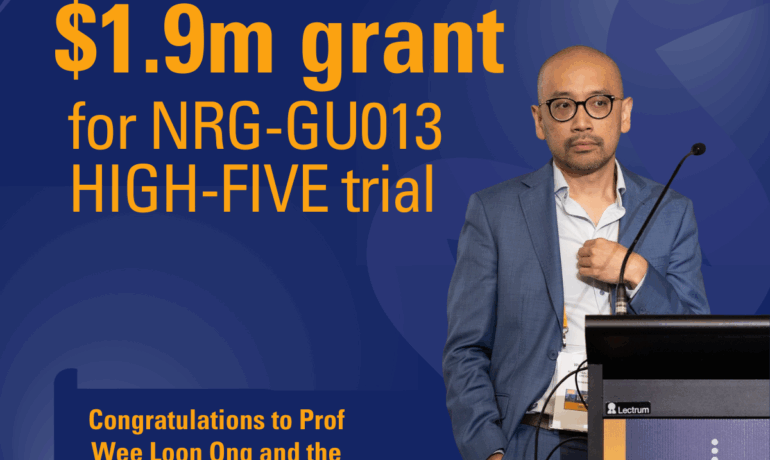Paving the way for success in prostate cancer treatment, TROG Cancer Research are helping to reduce common side effects and the length of treatment with the TROG 15.01 SPARK Trial.
The clinical trial, led by Professor Paul Keall and Professor Jarad Martin, proposes the use of kilovoltage intrafraction monitoring (KIM) alongside stereotactic body radiotherapy (SBRT) to provide more accurate results when targeting cancer cells.
With over 16,000 Australian men estimated to be diagnosed with prostate cancer in 2020, finding effective treatments for patients is a key goal of the SPARK Trial team and TROG Cancer Research.
The SPARK (Stereotactic Prostate Adaptive Radiotherapy utilising KIM) approach – a major shift in oncology
The first patient was recruited for the TROG 15.01 SPARK 15.01 Trial in early 2016. From there 49 patients became involved, with recruitment requiring that patients have a low to intermediate prostate cancer risk.
Patients were recruited across five different sites – Calvary Mater (Newcastle), Royal North Shore Hospital (Sydney), Liverpool Hospital (Sydney), Westmead Hospital (Sydney) and the Peter MacCallum Cancer Centre (Melbourne).
The trial followed each patient for 24 months after completing treatment to ensure success and to check that the disease did not re-occur. The last patient to have completed the two year follow up was in March 2020.
The goal of the clinical trial was to be able to:
- Test KIM’s cancer targeting accuracy,
- Analyse the impact of the targeting accuracy on the radiation dose received by a patient, and
- To assess the clinical outcomes, side effects and cancer control when using these treatments.
For the KIM technology to be deployed in multiple hospitals, the teams needed to be trained, prostate cancer patients recruited, consented, and treated resulting in terabytes of data that needed to be analysed. This required a collaborative effort across five hospitals and three states effort to make happen.
What resulted from the clinical trial is proposed to change the way prostate cancer patients are treated in the future.
A breakthrough for prostate cancer patients
The TROG 15.01 SPARK Trial stands out for multiple reasons.
The use of KIM technology is one of the main contributing factors, as it is the first-ever cancer treatment with real-time motion and rotation monitoring. This Australian-developed method is perfect for finding the position of cancer targets in real-time during the radiation therapy process.
Co-Chair of the clinical trial, Professor Paul Keall said that the accuracy of this technology provides an opportunity for cancer patients to receive better treatment, without the added time or bodily stress.
“If the [cancer] target moves, KIM detects this motion and enables this movement to be corrected so that the beam is always directed at the cancer target,” he said.
In addition to real-time motion and rotational monitoring success, the SPARK Trial was also the first treatment with real-time adaptive radiotherapy on a standard cancer radiation therapy system combined with multileaf collimator (MLC) tracking.
The benefits for cancer patients
With any TROG Cancer Research clinical trial, the goal is to ensure ongoing benefits for cancer patients.
For prostate cancer patients, the TROG 15.01 SPARK Trial presents the opportunity for larger doses of radiation therapy to be given at each treatment session. Ultimately, this means that the number of treatments needed are significantly reduced.
This trial is investigating the use of new technology to improve the accuracy of radiotherapy for prostate cancer patients reducing treatment from 40 visits to just five.
John Frasier, who was one of the first patients to sign-up to the TROG 15.01 SPARK Trial at Westmead Hospital, said his experience with the KIM radiation treatment was positive.
“When I was diagnosed with prostate cancer, I asked to see a radiation oncologist to discuss non-invasive options – they put me onto SPARK,” he said.
“SPARK was really what I wanted in terms of treatment – it’s less invasive, much shorter and I’ve had very few side-effects.
“The technology is just spectacular; it’s so precise and I really like how high-tech it is; it’s fantastic to be involved in something where constant study is happening, which will hopefully lead to improvements in the field.”
Conventional radiation therapy is administered over eight weeks, five times per week (40 treatment sessions). Alternatively, hypofractionated radiation therapy is also a common treatment option, administered over 4-6 weeks with 20-30 sessions.
With combined KIM and stereotactic body radiation, Professor Keall said treatment can be administered over a two-week period.
“The SPARK Trial enabled eligible patients to be safely treated in five treatments over two weeks instead of up to 40 treatments over eight weeks,” he said.
In addition to reducing the amount of treatments required, the KIM technology reduced the side effects commonly experienced after treatment due to the lower toxicity and less frequent treatment.
The KIM technology allows images of a tumour to be taken in real-time while the treatment is occurring. The advantage is it enables strategies such as patient shifting or beam shifting during treatment, which improves the accuracy of the treatment and potentially reduces the patient’s side effects.
“The SPARK Trial showed that real-time cancer targeting is clinically useful in improving the prostate and rectum dose when the cancer target moves during treatment.”
“With KIM demonstrating real-time cancer targeting on commonly available cancer radiation therapy systems, this may make real-time cancer targeting widely accessible for prostate cancer treatments.
“The successful completion of the trial demonstrated that bench-to-bedside clinical translational research is alive and well in Australia.”
Professor Keall said that he was thrilled with the results of the TROG 15.01 SPARK Trial and that they achieved their goals.
“SPARK achieved everything it set out to. I am proud of, and humbled by, the massive team effort that goes into completing a multi-centre TROG trial,” he said.
“Fortunately, my role was well supported by Dr Trang Nguyen, who worked tirelessly to support the clinical implementation and the SPARK physics Chair, Dr Jeremy Booth.
“My role worked extremely well in tandem with the clinical Chair, Professor Jarad Martin, who in addition to leading the recruitment personally, supported the patient recruitment at all five SPARK sites.”
“TROG Cancer Research were key to the trial success with their coordination, management and assistance with many of the patient safety aspects of the trial.”
The future of prostate cancer treatment
Professor Keall said that while the use of KIM technology so far has been limited, it’s expected this will change as more research proves the effectiveness of its use.
“To date, the KIM technology has now been used to treat over 100 patients with prostate cancer. KIM is being used in the treatment of liver cancer patients in the TROG 17.03 LARK Trial,” he said.
“We have plans to use KIM in additional cancer sites and add machine learning to improve its effectiveness. However, the KIM technology is not yet readily available in all cancer centres.
“As KIM is a research device, it can only be used in clinical trials. The more widespread use of KIM is dependent on working with industry partners.”
–
To learn more about the TROG 15.01 SPARK 15.01 Trial, check out the journal publication in the International Journal of Oncology.
The team at TROG Cancer Research are proud to be leaders in innovative solutions for cancer patients in Australia and around the world. To learn more about their leading research and current clinical trials, click here.
Related Post
TROG collaboration sees international skin cancer trial open in Australia
LATEST NEWS: 23 October 2025 TROG Cancer Research has
TROG brings international prostate cancer trial to Australia, thanks to $1.9 million MRFF grant
LATEST NEWS: 24 September 2025 TROG is set to




